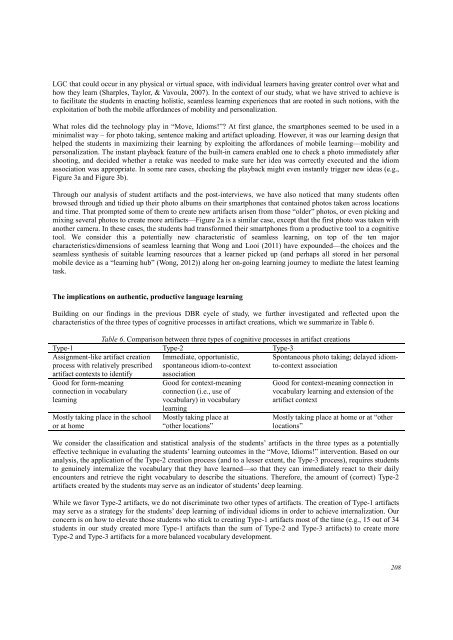Download Complete Issue in PDF - Educational Technology & Society
Download Complete Issue in PDF - Educational Technology & Society
Download Complete Issue in PDF - Educational Technology & Society
You also want an ePaper? Increase the reach of your titles
YUMPU automatically turns print PDFs into web optimized ePapers that Google loves.
LGC that could occur <strong>in</strong> any physical or virtual space, with <strong>in</strong>dividual learners hav<strong>in</strong>g greater control over what and<br />
how they learn (Sharples, Taylor, & Vavoula, 2007). In the context of our study, what we have strived to achieve is<br />
to facilitate the students <strong>in</strong> enact<strong>in</strong>g holistic, seamless learn<strong>in</strong>g experiences that are rooted <strong>in</strong> such notions, with the<br />
exploitation of both the mobile affordances of mobility and personalization.<br />
What roles did the technology play <strong>in</strong> “Move, Idioms!”? At first glance, the smartphones seemed to be used <strong>in</strong> a<br />
m<strong>in</strong>imalist way – for photo tak<strong>in</strong>g, sentence mak<strong>in</strong>g and artifact upload<strong>in</strong>g. However, it was our learn<strong>in</strong>g design that<br />
helped the students <strong>in</strong> maximiz<strong>in</strong>g their learn<strong>in</strong>g by exploit<strong>in</strong>g the affordances of mobile learn<strong>in</strong>g—mobility and<br />
personalization. The <strong>in</strong>stant playback feature of the built-<strong>in</strong> camera enabled one to check a photo immediately after<br />
shoot<strong>in</strong>g, and decided whether a retake was needed to make sure her idea was correctly executed and the idiom<br />
association was appropriate. In some rare cases, check<strong>in</strong>g the playback might even <strong>in</strong>stantly trigger new ideas (e.g.,<br />
Figure 3a and Figure 3b).<br />
Through our analysis of student artifacts and the post-<strong>in</strong>terviews, we have also noticed that many students often<br />
browsed through and tidied up their photo albums on their smartphones that conta<strong>in</strong>ed photos taken across locations<br />
and time. That prompted some of them to create new artifacts arisen from those “older” photos, or even pick<strong>in</strong>g and<br />
mix<strong>in</strong>g several photos to create more artifacts—Figure 2a is a similar case, except that the first photo was taken with<br />
another camera. In these cases, the students had transformed their smartphones from a productive tool to a cognitive<br />
tool. We consider this a potentially new characteristic of seamless learn<strong>in</strong>g, on top of the ten major<br />
characteristics/dimensions of seamless learn<strong>in</strong>g that Wong and Looi (2011) have expounded—the choices and the<br />
seamless synthesis of suitable learn<strong>in</strong>g resources that a learner picked up (and perhaps all stored <strong>in</strong> her personal<br />
mobile device as a “learn<strong>in</strong>g hub” (Wong, 2012)) along her on-go<strong>in</strong>g learn<strong>in</strong>g journey to mediate the latest learn<strong>in</strong>g<br />
task.<br />
The implications on authentic, productive language learn<strong>in</strong>g<br />
Build<strong>in</strong>g on our f<strong>in</strong>d<strong>in</strong>gs <strong>in</strong> the previous DBR cycle of study, we further <strong>in</strong>vestigated and reflected upon the<br />
characteristics of the three types of cognitive processes <strong>in</strong> artifact creations, which we summarize <strong>in</strong> Table 6.<br />
Table 6. Comparison between three types of cognitive processes <strong>in</strong> artifact creations<br />
Type-1 Type-2 Type-3<br />
Assignment-like artifact creation Immediate, opportunistic, Spontaneous photo tak<strong>in</strong>g; delayed idiom-<br />
process with relatively prescribed spontaneous idiom-to-context to-context association<br />
artifact contexts to identify association<br />
Good for form-mean<strong>in</strong>g<br />
Good for context-mean<strong>in</strong>g Good for context-mean<strong>in</strong>g connection <strong>in</strong><br />
connection <strong>in</strong> vocabulary connection (i.e., use of<br />
vocabulary learn<strong>in</strong>g and extension of the<br />
learn<strong>in</strong>g<br />
vocabulary) <strong>in</strong> vocabulary<br />
learn<strong>in</strong>g<br />
artifact context<br />
Mostly tak<strong>in</strong>g place <strong>in</strong> the school Mostly tak<strong>in</strong>g place at<br />
Mostly tak<strong>in</strong>g place at home or at “other<br />
or at home<br />
“other locations”<br />
locations”<br />
We consider the classification and statistical analysis of the students’ artifacts <strong>in</strong> the three types as a potentially<br />
effective technique <strong>in</strong> evaluat<strong>in</strong>g the students’ learn<strong>in</strong>g outcomes <strong>in</strong> the “Move, Idioms!” <strong>in</strong>tervention. Based on our<br />
analysis, the application of the Type-2 creation process (and to a lesser extent, the Type-3 process), requires students<br />
to genu<strong>in</strong>ely <strong>in</strong>ternalize the vocabulary that they have learned—so that they can immediately react to their daily<br />
encounters and retrieve the right vocabulary to describe the situations. Therefore, the amount of (correct) Type-2<br />
artifacts created by the students may serve as an <strong>in</strong>dicator of students’ deep learn<strong>in</strong>g.<br />
While we favor Type-2 artifacts, we do not discrim<strong>in</strong>ate two other types of artifacts. The creation of Type-1 artifacts<br />
may serve as a strategy for the students’ deep learn<strong>in</strong>g of <strong>in</strong>dividual idioms <strong>in</strong> order to achieve <strong>in</strong>ternalization. Our<br />
concern is on how to elevate those students who stick to creat<strong>in</strong>g Type-1 artifacts most of the time (e.g., 15 out of 34<br />
students <strong>in</strong> our study created more Type-1 artifacts than the sum of Type-2 and Type-3 artifacts) to create more<br />
Type-2 and Type-3 artifacts for a more balanced vocabulary development.<br />
208

















